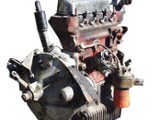Suggestions for a Successful Engine Run-in
Installing a new rebuilt engine in your car will give it a major “shot in the arm” in any number of ways. In order to get the most of this change we suggest that you take the time while the engine bay is empty to do a thorough cleaning of the area.
Pre-Installation Checklist
- We suggest you carefully examine such items as motor mounts; fuel, water and clutch hoses and replace them if they are cracked or stressed.
- This is also a good time to have the radiator checked by reputable shop and have any necessary repairs done.
- Be sure to check the condition of your electrics, looking for corroded connectors and frayed and /or broken wires (including battery and ground cables) since a bad ground or corroded connection can take away all the performance you are buying!
- Also carefully examine your fuel and hydraulic lines and repair or replace them now, while you have the room to do it comfortably.
- This is also the time to carefully check the carburetor(s) and rebuild if required. Look closely for play around the throttle shafts, since air can leak past a worn shaft and give you fits at tune-up time.
- Check and replace points, cap and rotor as needed and look for excess play in the distributor. Remember, some of our cars are 40 years old or better, so make the extra effort to give that new engine a good home!
Step by Step Run-in Procedures
Read these procedures thoroughly before starting your engine. Have a good shop manual nearby.
1. “Prime” the Oil Pump. Your Mini Mania rebuilt engine comes to you in a DRY condition. It has been put together with quality assembly lubricants in all the areas of high stress and extreme pressure, such as the cam and lifter interface, the crankshaft main and rod bearings and the valve train. It has not been pre-run or dynoed, so you will need to “prime” the oil pump while filling the sump for the first time.
2. Remove the spark plugs and turn over the engine with the starter until the oil pressure gauge shows full pressure.
Be sure to correctly fill the cooling system with the correct mix of coolant (anti-freeze) and water according to the manufacturers recommendations (also found elsewhere in this database) or use a water pump lubricant in the water.
3. Re-install the plugs and prepare to start the engine. The carburetor should have the jet tubes set 2 turns down from flush with the bridge and the needle(s) centered in the bore(s).
4. Start the engine and hold the engine speed at 2000-3000 RPM for at least 20 minutes. This ensures plenty of oil to the camshaft bearings. Speeds slower than 2000 RPM may starve a cam of oil. You may want to do this during the day to avoid disagreements with your neighbors.
5. After this initial run-in, retorque the cylinder head, HOT, to 50 ft/lbs and readjust the valves according to your shop manual.
NOTE: Do not exceed 3000 rpm for any prolonged period for the first 500 miles, at which time, change the oil and readjust the valves. After this you may gradually increase RPM limits over the next 1000 miles or so.








